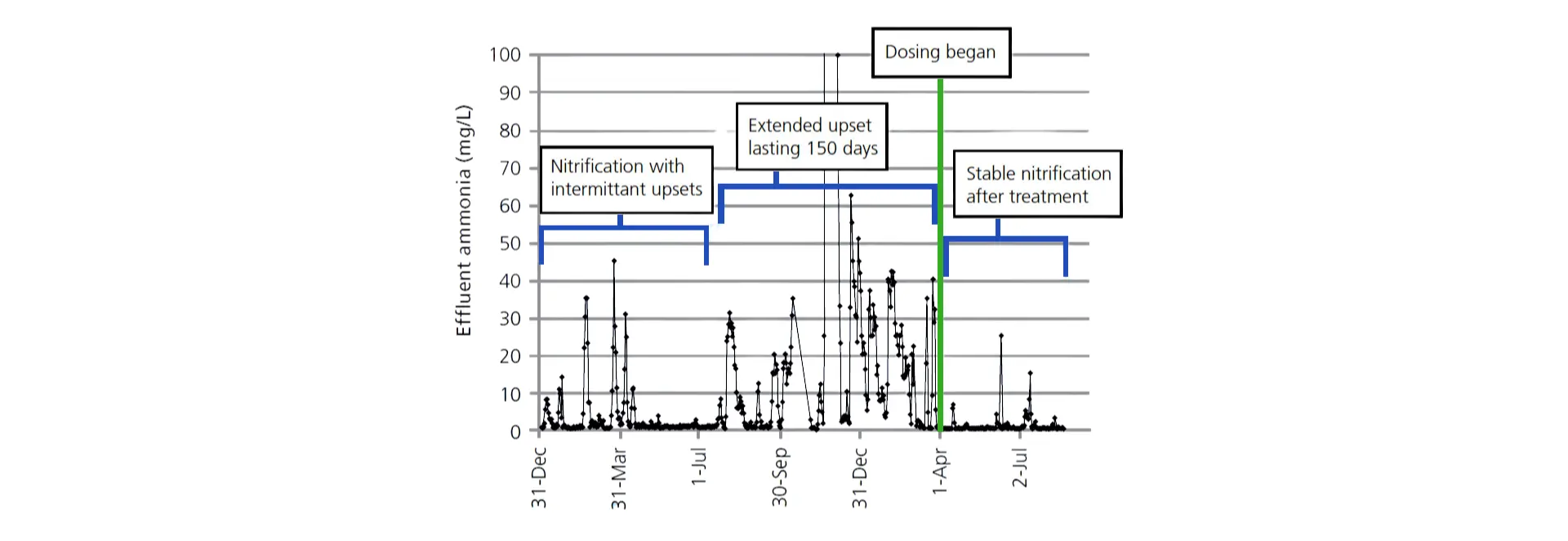
Rapid Nitrification Recovery Saves Plant $1 Million USD
BioRemove AM and HC were used at a refinery to quickly improve nitrification and circumvent the need for alternative treatment processes to dispose of ammonia-contaminated water.
Benefits
- Ammonia removal efficiency increased from 82% to 93%
- Average nitrification recovery time reduced from 10 to 3 days
- Operating costs lowered by processing 7 million gallons of storm water contaminated with urea ammonium nitrate (UAN), which would otherwise have to be disposed of at an estimated cost of $1 million USD
Background
The nitrification process is extremely important for plants in preventing violation of discharge permits. Nitrification can be affected by a number of factors, resulting in a process that can be tough to maintain, particularly with industrial waste streams.
One refinery had a history of nitrification upsets from UAN-contaminated storm water, with a typical recovery time of 10 days. An unusually high surge of UAN from a neighboring chemical plant caused a prolonged upset which lasted 150 days. During that time, the plant was in violation of its NPDES permit of 2.6 mg/L. Furthermore, the refinery had accumulated 26.5 million L (7 million gallons) of storm water, which had become contaminated with UAN. The contaminated water had a COD of 2,500 mg/L and an ammonium nitrogen concentration of 250 mg/L. The disposal costs were estimated at $1 million USD.
The refinery sought an easy-to-use alternative solution to disposal that would allow the wastewater plant to process the contaminated storm water and reduce UAN contamination to below effluent permit levels.
Application
The site was visited to evaluate the situation and determine whether a biological solution was feasible. The refinery operates a 7.75 million L/day (2 million gallons/day) wastewater treatment facility, which includes two large surge ponds and three parallel activated sludge basins. Both surge ponds contained contaminated storm water.
To stabilize nitrification in the activated sludge unit, BioRemove AM and BioRemove HC were recommended. BioRemove HC would significantly reduce the COD and phenol level in the water, making conditions more suitable for nitrification, while BioRemove AM would quickly fortify the nitrified population and improve ammonia removal in the unit.
Treatability studies were also performed to determine whether using BioRemove AM and BioRemove HC would allow the UAN-contaminated storm water to be fed into the influent wastewater stream without affecting the normal treatment process. By treating the contaminated storm water in the wastewater plant, the facility would realize substantial savings by not having to dispose of the water or treat it outside their existing wastewater system.
Results

On implementation of the recommended EnviroZyme products, the ammonia removal efficiency increased to 92%, with recovery taking only 3 days. Prior to using BioRemove AM, ammonia removal efficiency had averaged 82%, with an average recovery time of 10 days. During the prolonged upset period, the average ammonia removal efficiency was only 40%.
Conclusion
EnviroZyme's biological program was simple to implement and provided significant benefits compared to other disposal alternatives. By using BioRemove AM and HC, the refinery was able to stabilize nitrification and lower operating costs by processing UAN-contaminated storm water within its existing wastewater treatment facility.
The nitrification process is sensitive to operational changes and process fluctuations. Bio-innovations like BioRemove AM can restore nitrification and improve plant stability on an ongoing basis by reducing the effect of shock loads on the system. BioRemove AM resulted in:
- Lower operating costs
- Improved plant efficiency

